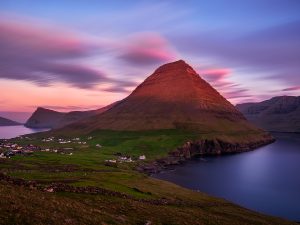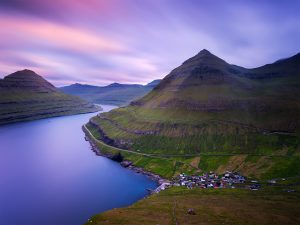 Faroe Islands
Faroe Islands
Fujifilm GFX 50S, Fujifilm 32-64mm @32mm, NiSi 10-stops ND filter
ISO-100, f/14, 120s
Have you ever seen the long exposure image using 10-stops ND filters? They are visually energetic and dynamic, due to the motion blur caused by the moving clouds over long duration of exposure. It is a common that most people trying to guess the exposure time when using these high strength ND filters, like 10-stops ND filters. However, I bet you don’t want to stand in the cold and windy beach for a 5 minutes long exposure shot during sunrise or sunset, and find out that your shot is over-exposed or under-exposed, and then retake with a minute more or less, keep trial-and-error by adjusting the exposure, and eventually the light is gone before you figure out the perfect exposure!
There is various way to calculate the exposure time especially when using the high strength ND filters like 10-stops ND filter, when the exposure metering goes beyond the camera’s capability. Here’s a few techniques that are generally used for exposure time calculation:
- Simple math
- Exposure calculation table
- Exposure calculator apps
- Reverse calculation
- “1-second exposure” technique
In theory, technique 1-3 should give very precise exposure time, however this is not always the case in higher strength ND filters like 10-stops ND filter. This is simply because 10-stops ND filters are not always 10-stops for many brands, they are often off by a stop due to the manufacturing difficulty. Therefore, by multiplying 1000 times can lead to inaccurate exposure. Technique 4 and 5 are particularly useful in this case, especially when you just bought a brand new 10-stops ND filter.
A very important consideration when doing long exposure photography is the change of light, especially during sunrise and sunset when the light changes very quickly over a short period of time. This is significantly noticeable when you are making extremely long exposure, let’s said 5 minutes or longer. During sunrise, the light is getting brighter, and there might be a risk of getting an over-exposed image. During sunset, the light is getting dimmer, and there might be a risk of getting an under-exposed image. This should be taken into consideration in order to get the correct exposure during these times of the day, i.e. by decrease the exposure time during sunrise and increase the exposure time during sunset accordingly.
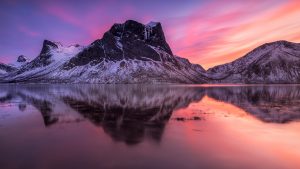 Senja Island, Norway
Senja Island, Norway
Canon 5D Mark IV, Canon 11-24mm, NiSi 10-stops ND filters
ISO-100, f/16, 240s
1. Simple Math
Sometime, the simple math will do the job very well! Here’s the formula to calculate final shutter speed:
Final shutter speed = Base shutter speed x 2n
(n is stop value of ND filter)
For 10-stops ND filter, if the base shutter speed (without filter) is ¼ seconds, with the use of 10-stops ND filter, the exposure time becomes ¼ x 210 = ¼ x 1000 = 250 seconds. To simplify the calculation, we always assume that 210 is equal to 1000 instead of 1024 since it is negligibly small.
For 6-stops ND filter, if the base shutter speed (without filter) is 2 seconds, with the use of 6-stops ND filter, the exposure time becomes 2 x 26 = 2 x 60 = 120 seconds. Similarly, to simplify the calculation, we assume that 26 is equal to 60 instead of 64.
As for 6-stops ND filter, you may require to calculate the exposure time under low light condition when the camera metering is no longer capable to estimate the shutter speed especially it is over 30 seconds for most camera.
6-stops ND: Final shutter speed = Base shutter speed x 60
10-stops ND: Final shutter speed = Base shutter speed x 1000
To make the calculation fast and easy for 10-stops ND filter in the field, you can adjust the aperture and ISO setting to make the base shutter speed an easy number, let’s said 1/10 seconds (1/10 x 1000 = 100 seconds for 10-stops ND) or 1/20 seconds (1/20 x 1000 = 50 seconds for 10-stops ND), to speed up the calculation in mind.
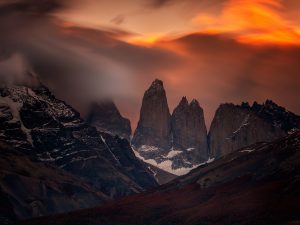 Patagonia, Chile
Patagonia, Chile
Fujifilm GFX 50R, Fujifilm GF 100-200mm @148mm, NiSi 6-stops ND filter
ISO-320, f/13, 25s
2. Exposure Calculation Table
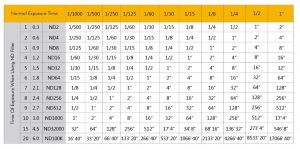
Exposure calculation table. Image reproduced with permission of NiSi.
You can use the table above, or compile your own exposure calculation table based on the formula in the above section, or download the chart online by simply searching “long exposure calculation table” or “long exposure calculation chart”. This is a useful table where you can find the appropriate shutter speed by choosing the base shutter speed and the strength of ND filter used.
It is very easy to use this table. First check the base shutter speed (without filter) in the first row, then go all the way down to the intersection with the column of ND filter, and this is your final shutter speed.
For example, the shutter speed without filter is ¼ seconds, and if you are going to use a 10-stops ND filter, go down to the intersection with the 10-stops and you will find 256 seconds as your final shutter speed.
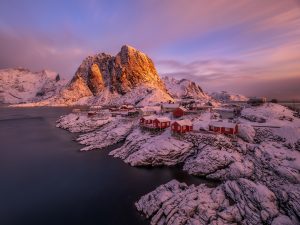 Lofoten, Norway
Lofoten, Norway
Fujifilm GFX 50R, Canon EF 11-24mm @24mm, NiSi 10-stops ND filter
ISO-100, f/16, 60s
3. Exposure Calculator Applications
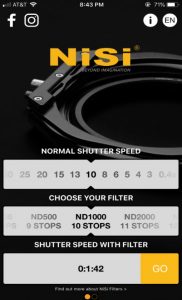
Exposure calculator apps. Image reproduced with permission of NiSi.
Everyone has mobile phone, therefore photography applications are getting popular these days. There are plenty of exposure calculator applications available for both Apple and Android, and most of them are free to download.
To mention but a few, NiSi Filters, Long Exposure Calculator, LongShot, Exposure-Calculator, Neutral Density Calculator, Slower Shutter Exposure Calculator, etc. Some apps like PhotoPills also carry the exposure calculator as part of function.
The use of these applications is very straightforward, just choose the base shutter speed (without filter) and the strength of ND filter, the apps will automatically calculate the final shutter speed. For most of the apps, if the final shutter speed is over 30 seconds, the countdown timer is automatically appeared. The countdown timer is convenience for many camera brands without timer when using the bulb exposure mode.
Faroe Islands
Fujifilm GFX 50R, Fujifilm GF 32-63mm @36mm, NiSi 10-stop ND
ISO-50, f/16, 240s
4. Reverse Calculation
First, set the shutter speed to 30 seconds, with ISO-100 and appropriate aperture. With the use of high strength ND filter, the camera metering may indicate the shot is under-exposed. Then, increase the ISO until the camera metering shows that the shot is well exposed (EV 0) and count the number of stops increased in ISO. Adjust the ISO back to 100. Finally, set the camera to B (bulb) exposure mode, increase the shutter speed to compensate the stops different in ISO.
For example, the shot with 30 seconds is well exposed at ISO-1600, which is 4-stops increased from ISO-100 (1600 > 800 > 400 > 200 >100). Therefore, the final shutter speed is 4-stops increment of 30 seconds (30 > 60 > 120 > 240 > 480) which is 480 seconds at ISO-100.
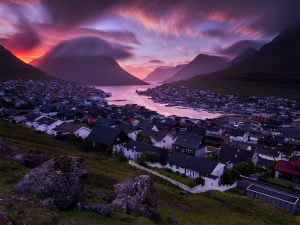 Faroe Islands
Faroe Islands
Fujifilm GFX 50S, Fujifilm GF 32-64mm @32mm, NiSi 10-stops ND
ISO-400, f/16, 240s
5. “1 Second Exposure” Technique
Here’s another way you can figure out the precise exposure within a second. This technique was first described by Sam Wang in his article published in 2008.
First, take a test shot by setting your camera to M mode (manual mode), ISO-6400, 1 second (Image 2a). Then check the overall exposure by viewing the histogram to make sure the test shot is well exposed. If yes, follow by setting your camera to B mode (bulb mode), ISO-100, 1 minute, with the same aperture used in the test shot (Image 2b).
What if the test shot of 1 second is under-exposed? Adjust the exposure time to 2 seconds at ISO-6400, which correspond to 2 minutes at ISO-100; 3 seconds correspond to 3 minutes; so on and so forth. Same for non-integer, for instance, 1.5 seconds correspond to 1.5 minutes. What if it is over-exposed? Adjust the exposure time to 0.5 seconds at ISO-6400, which correspond to 0.5 minutes at ISO-100.
The principle of “1 second exposure” technique is simple if you understand the principle of exposure triangle. There are 6-stops decrement from ISO-6400 to ISO-100 (6400 > 3200 > 1600 > 800 > 400 > 200 > 100). 6-stops decrement results in 26 = 64 times decrease in exposure. On the other hand, 1 minute is 60 times longer than 1 second. Therefore, 60x increase in exposure time compensate 60x decrease in ISO sensitivity.
What if the exposure time is way longer than desired, let’s said 10 minutes and you want to make it shorter? You can easily play around with ISO or aperture. For example, if the exposure time is 10 minutes at ISO-100, you can decrease the exposure to 5 minutes at ISO-200 or 2.5 minutes at ISO-400; if the exposure time is 10 min at f/16, you can decrease the exposure to 5 minutes at f/11, or 2.5 min at f/8.
 “1 sec exposure” technique can also be used with 6-stops ND filter in low light condition when it is impossible to estimate the exposure with camera metering, especially the resulting exposure time is more than 30 seconds for most camera. It can also be use on higher strength ND filters, like 15-stops ND filter.
“1 sec exposure” technique can also be used with 6-stops ND filter in low light condition when it is impossible to estimate the exposure with camera metering, especially the resulting exposure time is more than 30 seconds for most camera. It can also be use on higher strength ND filters, like 15-stops ND filter.
You can even use “1 sec exposure” technique in night photography when no ND filter is used. Most people are still practicing trial-and-error to obtain the perfect exposure in night photography.


